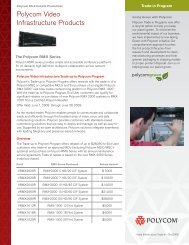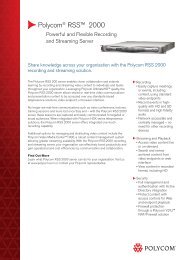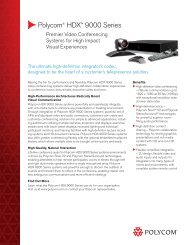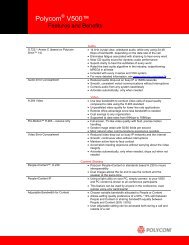Polycom DMA 7000 System Operations Guide
Polycom DMA 7000 System Operations Guide
Polycom DMA 7000 System Operations Guide
Create successful ePaper yourself
Turn your PDF publications into a flip-book with our unique Google optimized e-Paper software.
Recommended Regular Maintenance<br />
<strong>System</strong> Management<br />
Perform the following tasks to keep your <strong>Polycom</strong> <strong>DMA</strong> system operating<br />
trouble-free and at peak efficiency. These tasks can be done quickly and<br />
should be run at least weekly.<br />
Regular archive of backups<br />
Log into the <strong>Polycom</strong> <strong>DMA</strong> system, go to <strong>System</strong> Management > Software<br />
Management > Backup and Restore, and check for new backups. If there are<br />
new backups, download and archive the latest one.<br />
Every night, the <strong>Polycom</strong> <strong>DMA</strong> system determines whether its configuration<br />
or database data have changed since the last time it performed a backup. If so,<br />
it creates a new backup instance. For details on backups, see “Backing Up and<br />
Restoring” on page 3-8.<br />
General system health and capacity checks<br />
On the Dashboard (see “Dashboard” on page 3-5), verify that no alerts are<br />
visible and that:<br />
• The system didn’t run out of capacity at any point in time. If the Capacity<br />
Usage History graph shows spikes at or near the system’s maximum<br />
capacity, it may be time to add more.<br />
• All the expected MCUs are connected, in service, and have the expected<br />
capacities. If there appear to be issues with an MCU, check its<br />
configuration and status, and if necessary, call <strong>Polycom</strong> Global Services.<br />
See “Device Management” on page 7-1.<br />
• The Gatekeeper Status section indicates the status of the gatekeeper<br />
connection is OK, and that the network latency between the system and<br />
gatekeeper is within the range you would expect for your network (it may<br />
be helpful to keep latency records for comparison over time). If it isn’t,<br />
contact your network administrator or <strong>Polycom</strong> Global Services.<br />
• The Network Status section shows two cluster members, one of which is<br />
the active web host, and indicates that the public and private network<br />
interfaces for both nodes are in a good state (upward green arrow) and<br />
have the expected speeds:<br />
— For Private, 1000 Mbps / Full. Errors on the private link may indicate<br />
a problem with the <strong>Polycom</strong> <strong>DMA</strong> system. Check the crossover cable<br />
connecting the two servers. If necessary, shut down both servers,<br />
replace the crossover cable, and restart the servers. If that doesn’t<br />
solve the problem, contact <strong>Polycom</strong> Global Services.<br />
— For Public, the speed you expect for your network. Errors on the<br />
public link may indicate an error in the interface between the <strong>Polycom</strong><br />
<strong>DMA</strong> system and your network. Contact your network administrator<br />
to resolve the issue.<br />
<strong>Polycom</strong>, Inc. 3–3
















